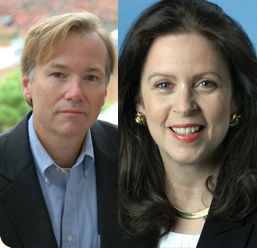Authors on Middle East Speak at UCSB
Arts & Lectures Presents Steve Coll and Robin Wright

UCSB’s Arts & Lectures presented two authors renowned for their work on the Middle East last night-Steve Coll and Robin Wright. Coll, a two time Pulitzer Prize winner and writer for the New Yorker, spoke about his recently released book, The Bin Ladens: An Arabian Family in the American Century, while Wright introduced Dreams and Shadows: The Future of the Middle East, an account of Middle Eastern problem solving through the eyes of a reporter who has worked in the region since 1973.
Coll’s in-depth look at the family which begat one of the most successful terrorist organizers in history included slides of the Bin Laden family-looking a lot like the Brady Bunch-dating from the 1960s and 1970s. Filling in the gap left by American contractors who were unable to play the game of Saudi politics, Coll followed Mohammed Bin Laden’s ascent to becoming one of the most successful contractors in the Middle East. From his successful father to his charismatic, playboy elder brother, Salaam, Coll noted that a number of influences shaped Osama Bin Laden while he was growing up. Intelligent and talented, Salaam was known for living a flashy life, but despite his contrast with the conservative Osama, he maintained close ties with his brother until he died in a sport airplane accident in May, 1988. Two months after Salaam’s death, Osama formed Al Quaeda.
Not least amongst Osama’s childhood influences were the Egyptian and Syrian teachers who comprised the Muslim Brotherhood when he attended boarding school in Egypt during the 1970s. Although his mother was a modern Middle Eastern woman who raised Osama in a posh Saudi suburb, Osama identified with the fundamental Islamists. “Osama was an ardent Islamist,” said Coll. “He went to Afghanistan as a Muslim Brother, as a representative of the family business, and in line with both Saudi and U.S. policy.” However, having learned from the charismatic qualities of his father and brother, Osama was able to garner a diversity never before seen in a terrorist organization. “As a Bin Laden, he was a pluralistic guy and embraced technology. He also used the media:and knew how to create and market a brand. Even as a terrorist he was incredibly successful.”
Wright’s account focused on more recent events in the Middle East. As a U.S. Foreign Policy reporter for the Washington Post and the New York Times, she had worked in the Middle East since 1973, arriving in Lebanon at the outset of the Yom Kippur War. “This book came out of my deep frustration with the U.S. not understanding what was going on in Iraq before we went in,” she said. Traveling back to the region recently, she interviewed people in all 22 Muslim countries and Israel to get an idea of what, if anything, has changed. “What struck me when I went back to the Middle East was that Islamic extremism is not the most interesting, dynamic thing anymore. We have begun-and I emphasize begun-to see a budding culture of change.”
She noted that people, tired of the continued violence, corruption, and unrest in the region, have started seeking practical, rather than ideological approaches to problem solving, focusing more that ever upon the infrastructure needs that she feels have been neglected in many areas. Through their use of the internet and other information sources to circumvent state controlled media outlets, people have been making themselves heard and calling their governments to task in a more constructive way than was ever possible before now. “For all of them, the preferred means of expression was peaceful. They were looking for alternate ways of engaging, not resorting to violence.”



